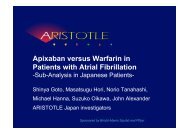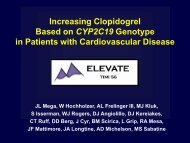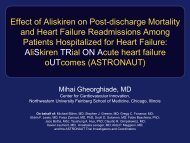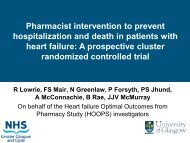Slides - Clinical Trial Results .org
Slides - Clinical Trial Results .org
Slides - Clinical Trial Results .org
- No tags were found...
Create successful ePaper yourself
Turn your PDF publications into a flip-book with our unique Google optimized e-Paper software.
<strong>Results</strong> of the IMMEDIATE (Immediate Myocardial<br />
Metabolic Enhancement During Initial Assessment<br />
and Treatment in Emergency Care) <strong>Trial</strong>:<br />
A Double-Blinded Randomized Controlled <strong>Trial</strong> of<br />
Intravenous Glucose, Insulin & Potassium (GIK)<br />
for Acute Coronary Syndromes<br />
in Emergency Medical Services<br />
Harry Selker MD MSPH; Joni Beshansky RN MPH;<br />
Patricia Sheehan RN MPH; Robin Ruthazer MPH; John Griffith PhD;<br />
James Udelson MD; Joseph Massaro PhD; Ralph D’Agostino PhD;<br />
for the IMMEDIATE <strong>Trial</strong> Investigators<br />
Support by NIH National Heart, Lung and Blood Institute U01HL077821
Disclosure / Conflict of Interest<br />
There are no commercial, financial or other relationships<br />
related to the subject of this presentation that may create any<br />
potential conflict of interest.
Carl Apstein, MD, FACC<br />
The IMMEDIATE <strong>Trial</strong><br />
investigators would like to<br />
thank and honor the<br />
memory of Carl Apstein, MD,<br />
whose groundbreaking basic<br />
research was a foundation<br />
for this study, and whose<br />
vision, energy, good humor,<br />
and persistence were critical<br />
to the initiation of this study.
Background: Mechanisms of GIK Cardiac Protection<br />
Experimental studies show that GIK myocardial metabolic support,<br />
started immediately in cardiac ischemia, followed by reperfusion<br />
• Improves glucose, glycogen, and energy metabolism, and<br />
mantains cellular ATP levels<br />
• Supports cardiac function and delays necrosis<br />
• Decreases plasma and cellular free fatty acid (FFA) levels<br />
(FFAs damage membranes, cause arrhythmias, waste oxygen)<br />
• Preserves myocyte potassium (anti-arrhythmic)
Background: Rationale for Placebo-Controlled <strong>Trial</strong> of<br />
Very Early Emergency Medical Service (EMS) Use of GIK<br />
• Experimental studies have shown the greatest benefit by GIK<br />
when started very early in ischemia, and yet<br />
– Prior trials have given GIK at the hospital, once AMI or STEMI<br />
is documented, on order of 6 hours after ischemia onset<br />
– Prior trials for STEMI have not started GIK before reperfusion<br />
• Prior GIK trials for AMI/STEMI have not been placebo-controlled<br />
• The best way to translate experimental results into clinical<br />
practice is by having paramedics give GIK to patients with ACS<br />
immediately, in the community
Study Purpose<br />
This trial investigated two types of potential benefit of GIK:<br />
• Protection of the myocardium from ischemia, which should<br />
– limit progression to MI<br />
– reduce ultimate infarct size<br />
• Prevention of arrhythmias and cardiac arrest that occur very<br />
early in ACS/AMI, associated with elevated free fatty acids
Methods: Basic Features of Study Design<br />
• Very early use of GIK (30% glucose + 50U insulin + 80mEq KCL<br />
per liter @1.5 ml/kg/hr) initiated by paramedics, continued by<br />
ED physicians for continued use in-hospital for a total 12 hours<br />
• Placebo-controlled double-blinded randomized clinical trial,<br />
• An effectiveness trial rather than the usual efficacy trial<br />
• Use of GIK for acute coronary syndromes (not just AMI/STEMI)<br />
• To help paramedics best identify patients with ACS, EMS use of<br />
predictive instrument decision support printed on ECGs
Ambulance ECG with ACI-TIPI and TPI Decision Support
Methods: Pre-Specified Endpoints<br />
• Primary endpoint<br />
– Progression to MI confirmed by biomarkers and ECGs<br />
• Major secondary endpoints<br />
– Pre- or in-hospital cardiac arrest or mortality<br />
– 30-day mortality (and 1-year mortality)<br />
– Hospitalization for heart failure or death within 30 days<br />
(and within 1 year)<br />
• Biological mechanism cohort endpoints<br />
– Infarct size by sestamibi perfusion imaging at 30 days<br />
– LVEF by sestamibi gated SPECT at 30 days<br />
– Free fatty acid levels at infusion start, 6, and 12 hours
Methods: Inclusion Criteria<br />
• Age 30 or older seen by EMS for symptoms consistent with ACS<br />
• Paramedic judgment that clinical picture suggests ACS/AMI and<br />
prehospital 12-lead ECG has at least one of the following:<br />
– ACI-TIPI predicted probability of ACS of 75% or more<br />
– Thrombolytic predictive instrument (TPI) detection of STEMI<br />
– STEMI identified based on local EMS protocol
Methods: Exclusion Criteria<br />
• HF evidenced by rales more than halfway up lung fields<br />
• End stage renal failure requiring dialysis<br />
• Language barrier or inability to understand informed<br />
consent<br />
• Patient known to be pregnant
Methods: Enrollment and Oversight<br />
• 36 EMS systems in 13 cities across the United States<br />
• <strong>Trial</strong> used Exception from Informed Consent Requirements for<br />
Emergency Research (21CFR 50.24) procedures<br />
– Community consultation process<br />
– Information card read to patient by paramedic to get assent<br />
prior to randomization<br />
– Written consent when stable at receiving hospital<br />
• Oversight by NIH-appointed DSMB
Methods: Analysis<br />
• Sample size calculation projected the need for 800 evaluable<br />
participants for 90% power to detect a 20% reduction in<br />
progression to MI (from 56% to 44%)<br />
• Blinded adjudication of endpoints by <strong>Clinical</strong> Events Committee<br />
• Logistic regression for comparisons of dichotomous endpoints<br />
• Cox proportional hazards regressions for time-to-event endpoints<br />
• Statistical testing used 2-sided 0.05 level of significance<br />
• Three analytic cohorts<br />
– Intention-to-treat (ITT)<br />
– Presenting with ST elevation<br />
– Biological mechanism
<strong>Results</strong>: Screening and Enrollment of Participants<br />
9-1-1 Called<br />
54,579 out-of-hospital ECG and assessed for eligibility<br />
50,418 ECG without acute ischemia<br />
1,345 No acute ischemia symptoms<br />
1,333 Exclusion criteria met<br />
1,483 Eligible<br />
396 Not asked to participate<br />
1,087 Asked by paramedic to participate<br />
911 Patients randomized by EMS<br />
176 Study drug not started<br />
432 Randomized – GIK 479 Randomized – Placebo
<strong>Results</strong>: Screening and Enrollment of Participants<br />
432 Randomized – GIK 479 Randomized – Placebo<br />
21 Declined to<br />
provide consent<br />
19 Declined to<br />
provide consent<br />
411 ITT Cohort<br />
(163 Presenting ST Elevation Cohort)<br />
460 ITT Cohort<br />
(194 Presenting ST Elevation Cohort)<br />
68 Biological<br />
Mechanism Cohort<br />
75 Biological<br />
Mechanism Cohort<br />
30-Day follow-up (100% complete )<br />
30-Day follow-up (100% complete)
<strong>Results</strong>: Presenting Characteristics (N=871)<br />
GIK<br />
(n=411)<br />
Placebo<br />
(n=460)<br />
Age (mean, yrs) 64 63<br />
Men 73% 70%<br />
White/Black/Hispanic (%) 82/13/11% 87/9/13%<br />
Chest pain chief complaint 87% 85%<br />
Shortness of breath chief complaint 4% 4%<br />
Pre-hospital systolic BP (mean, mmHg) 143 143<br />
Pre-hospital HR (mean, BPM) 87 87<br />
History of DM 29% 26%<br />
History of HF 17% 17%<br />
History of MI 37% 35%
<strong>Results</strong>: Time from Ischemic Symptom Onset<br />
to EMS Start of Study Drug Infusion<br />
GIK<br />
(n=411)<br />
Placebo<br />
(n=460)<br />
Time from symptom onset to study drug<br />
(median, mins [IQR]) 90 [50-159] 90 [52-159]<br />
Time from symptom onset to study drug<br />
0-30 mins 6% 4%<br />
31-60 mins 25% 27%<br />
61-90 mins 15% 16%<br />
91-180 mins 17% 18%<br />
181-360 mins 12% 12%<br />
361 mins-24 hrs 9% 8%<br />
Patients received primary PCI 48% 45%
<strong>Results</strong>: ITT Cohort<br />
Hospital and 30-Day Endpoints<br />
GIK<br />
(n=411)<br />
Placebo<br />
(n=460)<br />
Risk Ratio<br />
(95% CI) P Value<br />
Progression to MI 49% 53% 0.88 (0.66-1.13) 0.28
<strong>Results</strong>: ITT Cohort<br />
Hospital and 30-Day Endpoints<br />
GIK<br />
(n=411)<br />
Placebo<br />
(n=460)<br />
Risk Ratio<br />
(95% CI) P Value<br />
Progression to MI 49% 53% 0.88 (0.66-1.13) 0.28<br />
30-Day Mortality 4% 6% 0.72 (0.40-1.29) 0.27
<strong>Results</strong>: ITT Cohort<br />
Hospital and 30-Day Endpoints<br />
GIK<br />
(n=411)<br />
Placebo<br />
(n=460)<br />
Risk Ratio<br />
(95% CI) P Value<br />
Progression to MI 49% 53% 0.88 (0.66-1.13) 0.28<br />
30-Day Mortality 4% 6% 0.72 (0.40-1.29) 0.27<br />
Cardiac Arrest or Hospital 4% 9% 0.48 (0.27-0.85) 0.01<br />
Mortality<br />
Cardiac Arrest 4% 6% 0.56 (0.30-1.07) 0.08<br />
Hospital Mortality 3% 5% 0.62 (0.31-1.24) 0.18
<strong>Results</strong>: ITT Cohort<br />
Hospital and 30-Day Endpoints<br />
GIK<br />
(n=411)<br />
Placebo<br />
(n=460)<br />
Risk Ratio<br />
(95% CI) P Value<br />
Progression to MI 49% 53% 0.88 (0.66-1.13) 0.28<br />
30-Day Mortality 4% 6% 0.72 (0.40-1.29) 0.27<br />
Cardiac Arrest or Hospital 4% 9% 0.48 (0.27-0.85) 0.01<br />
Mortality<br />
Cardiac Arrest 4% 6% 0.56 (0.30-1.07) 0.08<br />
Hospital Mortality 3% 5% 0.62 (0.31-1.24) 0.18<br />
30-Day Mortality or<br />
Hospitalization for HF<br />
6% 8% 0.73 (0.43-1.23) 0.24
<strong>Results</strong>: Cohort Presenting with ST Elevation<br />
Hospital and 30-Day Endpoints<br />
GIK<br />
(n=163)<br />
Placebo<br />
(n=194)<br />
Risk Ratio<br />
(95% CI) P Value<br />
Progression to MI 85% 89% 0.74 (0.40-1.38) 0.34
<strong>Results</strong>: Cohort Presenting with ST Elevation<br />
Hospital and 30-Day Endpoints<br />
GIK<br />
(n=163)<br />
Placebo<br />
(n=194)<br />
Risk Ratio<br />
(95% CI) P Value<br />
Progression to MI 85% 89% 0.74 (0.40-1.38) 0.34<br />
30-Day Mortality 5% 8% 0.63 (0.27-1.49) 0.29
<strong>Results</strong>: Cohort Presenting with ST Elevation<br />
Hospital and 30-Day Endpoints<br />
GIK<br />
(n=163)<br />
Placebo<br />
(n=194)<br />
Risk Ratio<br />
(95% CI) P Value<br />
Progression to MI 85% 89% 0.74 (0.40-1.38) 0.34<br />
30-Day Mortality 5% 8% 0.63 (0.27-1.49) 0.29<br />
Cardiac Arrest or Hospital<br />
Mortality<br />
6% 14% 0.39 (0.18-0.82) 0.01<br />
Cardiac Arrest 6% 11% 0.49 (0.23-1.03) 0.06<br />
Hospital Mortality 4% 7% 0.49 (0.18-1.31) 0.16
<strong>Results</strong>: Cohort Presenting with ST Elevation<br />
Hospital and 30-Day Endpoints<br />
GIK<br />
(n=163)<br />
Placebo<br />
(n=194)<br />
Risk Ratio<br />
(95% CI) P Value<br />
Progression to MI 85% 89% 0.74 (0.40-1.38) 0.34<br />
30-Day Mortality 5% 8% 0.63 (0.27-1.49) 0.29<br />
Cardiac Arrest or Hospital<br />
Mortality<br />
6% 14% 0.39 (0.18-0.82) 0.01<br />
Cardiac Arrest 6% 11% 0.49 (0.23-1.03) 0.06<br />
Hospital Mortality 4% 7% 0.49 (0.18-1.31) 0.16<br />
30-Day Mortality or<br />
Hospitalization for HF<br />
6% 10% 0.56 (0.25-1.23) 0.15
<strong>Results</strong>: ITT Cohort Subgroups of <strong>Clinical</strong> Interest<br />
for Cardiac Arrest or Hospital Mortality<br />
ITT Subgroup<br />
Odds Ratio (95% CI)<br />
P Value<br />
All 0.48 (0.27-0.85)<br />
0.01<br />
Age: < 65 years 0.52 (0.22-1.21)<br />
Age: ≥ 65 years 0.43 (0.20-0.94)<br />
0.13<br />
0.04<br />
Time from symptom onset to study drug start<br />
0 - 1 hour 0.28 (0.10-0.79)<br />
> 1 hour - 6 hours 0.39 (0.13-1.25)<br />
> 6 hours 1.18 (0.34-4.06)<br />
0.02<br />
0.11<br />
0.79<br />
Diabetic 0.31 (0.10-0.99)<br />
Not Diabetic 0.56 (0.29-1.09)<br />
0.05<br />
0.09<br />
STEMI, Primary PCI 0.43 (0.18-1.00)<br />
STEMI, Not Primary PCI 0.16 (0.03-0.80)<br />
0.03 0.06 0.125 0.25 0.5 1.0 2.0 4.0<br />
Odds Ratio<br />
0.05<br />
0.03<br />
GIK better<br />
Placebo better
Median infarct size (IQR)<br />
<strong>Results</strong>: Biological Mechanism Cohort (N=153)<br />
30-Day Infarct Size, LVEF, and Free Fatty Acid Levels<br />
30-Day Infarct Size<br />
(% of LV mass)<br />
GIK<br />
Placebo<br />
25<br />
20<br />
p=0.01<br />
p=0.05<br />
65<br />
60<br />
578<br />
591<br />
64<br />
61<br />
367<br />
15<br />
10<br />
10<br />
12<br />
354<br />
5<br />
0<br />
2<br />
3<br />
All<br />
ST Elevation
Median infarct size (IQR)<br />
<strong>Results</strong>: Biological Mechanism Cohort (N=153)<br />
30-Day Infarct Size, LVEF, and Free Fatty Acid Levels<br />
Median LVEF (IQR)<br />
30-Day Infarct Size<br />
(% of LV mass)<br />
GIK Placebo<br />
LVEF (%)<br />
25<br />
20<br />
p=0.01<br />
p=0.05<br />
70<br />
60<br />
50<br />
p=0.13<br />
65<br />
60<br />
p=0.46<br />
578<br />
591<br />
15<br />
40<br />
64<br />
61<br />
367<br />
10<br />
5<br />
0<br />
2<br />
All<br />
10<br />
3<br />
12<br />
ST Elevation<br />
30<br />
20<br />
10<br />
0<br />
All<br />
ST Elevation<br />
354
Median infarct size (IQR)<br />
<strong>Results</strong>: Biological Mechanism Cohort (N=153)<br />
30-Day Infarct Size, LVEF, and Free Fatty Acid Levels<br />
Median LVEF (IQR)<br />
Mean FFA (95% CI)<br />
25<br />
20<br />
30-Day Infarct Size<br />
(% of LV mass)<br />
p=0.01<br />
p=0.05<br />
70<br />
60<br />
50<br />
GIK Placebo<br />
LVEF (%)<br />
p=0.13 p=0.46<br />
65<br />
60<br />
700<br />
600<br />
500<br />
FFA (umol/L)<br />
p
<strong>Results</strong>: ITT Cohort Selected Safety Endpoints<br />
GIK<br />
(n=411)<br />
Placebo<br />
(n=460)<br />
P value<br />
Serious Adverse Events 7% 9% 0.26<br />
Heart Failure 2% 3% 0.47<br />
All Participants<br />
Any K+ > 5.5 mEq/L 4% 2% 0.10<br />
Any K+ < 3.5 mEq/L 25% 30% 0.10<br />
Any glucose >300 mg/dL 21% 10% < 0.001<br />
Participants with Diabetes<br />
Any glucose >300 mg/dL 44% 29% 0.02<br />
Participants without Diabetes<br />
Any glucose >300 mg/dL 11% 3% < 0.001
Limitations<br />
• Primary endpoint progression to MI was not significantly<br />
different between groups -- favorable results based on prespecified<br />
major secondary endpoints, biologically consistent<br />
with the GIK benefit seen in pre-clinical studies<br />
• Absolute numbers of clinical endpoints were relatively small<br />
• Reduction in infarct size results, although consistent with<br />
experimental studies of early GIK, based on the relatively small<br />
biological mechanism cohort<br />
• Understanding of the long-term effects of GIK on HF and<br />
mortality will require longer follow-up, underway
Conclusions<br />
• Immediate EMS administration of GIK very early in the course of<br />
ACS and STEMI, consistent with preclinical research, can be done<br />
in a wide range of communities and EMS systems<br />
• Progression to infarction, the primary endpoint, was not<br />
prevented, but infarct size was significantly diminished<br />
• Composite endpoint of cardiac arrest or acute mortality was<br />
significantly reduced, and FFA levels were lower, consistent with<br />
the proposed FFA link to arrhythmias<br />
• Risks and side effects rates from GIK are very low, and GIK is<br />
inexpensive, potentially available in all communities, and<br />
deserves further evaluation in trials for widespread EMS use
James Atkins • Assaad Sayah • Michael Levy • Michael Richards • Tom Aufderheide • Darren Braude • Ronald<br />
Pirrallo • Delanor Doyle • Ralph Frascone • Donald Kosiak • James Leaming • Carin Van Gelder • Gert-Paul<br />
Walter • Marvin Wayne • Robert Woolard • Patrica Desvigne-Nickens • Yves Rosenberg • Lynn Rundhaugen •<br />
Xin Tian • Joseph Ornato • Jessica Berg • Robert Gropler • Kerry Lee • Heinrich Taegtmeyer • Douglas Weaver •<br />
Len Cobb • Joanne Ingwall • Thomas Killip • Gus Lambrew • Bruce MacLeod • Lionel Opie • Charles Rackley •<br />
Robert Zalenski • Lillian Burdick • Sarina Ge<strong>org</strong>e • Ellen Vickery • Manlik Kwong • Nira Hadar • Viet Cai • William<br />
Rui • Sam Yang • Catherine Ide • Carol Seidel • Muriel Powers • Jordan Goldberg • Michael Deitschman • Rural<br />
Metro Ambulance • Kelly Joiner • Glynnis Haley • Medical Center of Central Ge<strong>org</strong>ia EMS • Joseph Schepis •<br />
Patricia Baum • Judy Pendleton • Sergio Waxman • Emerson Hospital EMS • Michelle Moore • Michael Crotty •<br />
Stephen Poggi • Anne Sigsworth • Jeffrey Myers • Anchorage Fire Department • Tammy Floore • Drue Bralove •<br />
Paul Bearce • Vance Smith • Philip Froman • Silas Bussmann • Susan Salazar • Rae Woods • Kathleen Allen •<br />
Albuquerque Ambulance Service • Albuquerque Fire Department • Rio Rancho Fire Rescue • Sandoval County<br />
Fire Department • Janice Lapsansky • Whatcom Medic One EMS • Sandi Wewerka • Kent Griffith • Joshua<br />
Salzman • Marshall Washick • Keith Allen Wesley • Cottage Grove EMS • HealthEast Medical Transportation •<br />
Lakeview Hospital EMS • Mahtomedi Fire Department • Maplewood Fire Department • Oakdale Fire<br />
Department • White Bear Lake Fire Department • Carol Metral • Richard Herman • Kenneth Lawson • American<br />
Medical Response Brockton • Bridgewater Fire Department • Whitman Fire Rescue EMS • Karen Pickard • Ryan<br />
Dikes • Raymond Fowler • Jeffrey Goodloe • Wendy Lowe • Claudette Lohr • Timothy Starling • Barbara Moses<br />
• Dallas Fire Rescue • Duncanville Fire Department • Irving Fire Department • Plano Fire Department• Kevin<br />
Gardner • Stacey Cleary • Life Lion EMS • Milwaukee Fire Department • North Shore Fire Department •<br />
Wauwatosa Fire Department • West Allis Fire Department • Adolph Ulloa • Gloria Soto • Susan Watts • David<br />
Gough • Randy Goldstein • Ken Berumen • Otto Drozd • Brian Wilson • Yolie Salas • Larry Rascon • El Paso Fire<br />
Department • Radu Radulescu • Albert Gambino • American Medical Response New Haven • Branford Fire<br />
Department • East Haven Fire Department • Hamden Fire Department • New Haven Fire Department • West<br />
Haven Fire Department • West Shore Fire District • Jon Levine • Stewart Fenniman • Jeanine Miller • Louis<br />
Durkin • Kelly Hart • Michael Stevens • Kimberlin Marshall • Danielle Rodrick • Deborah Wallace • Claudia<br />
Thum • Derek Depelteau • Steve Mayes • William Harris • Debra Kinan • Loreen Wright • Juan Mendez
Published Online First<br />
March 27, 2012<br />
Available at<br />
www.jama.com






